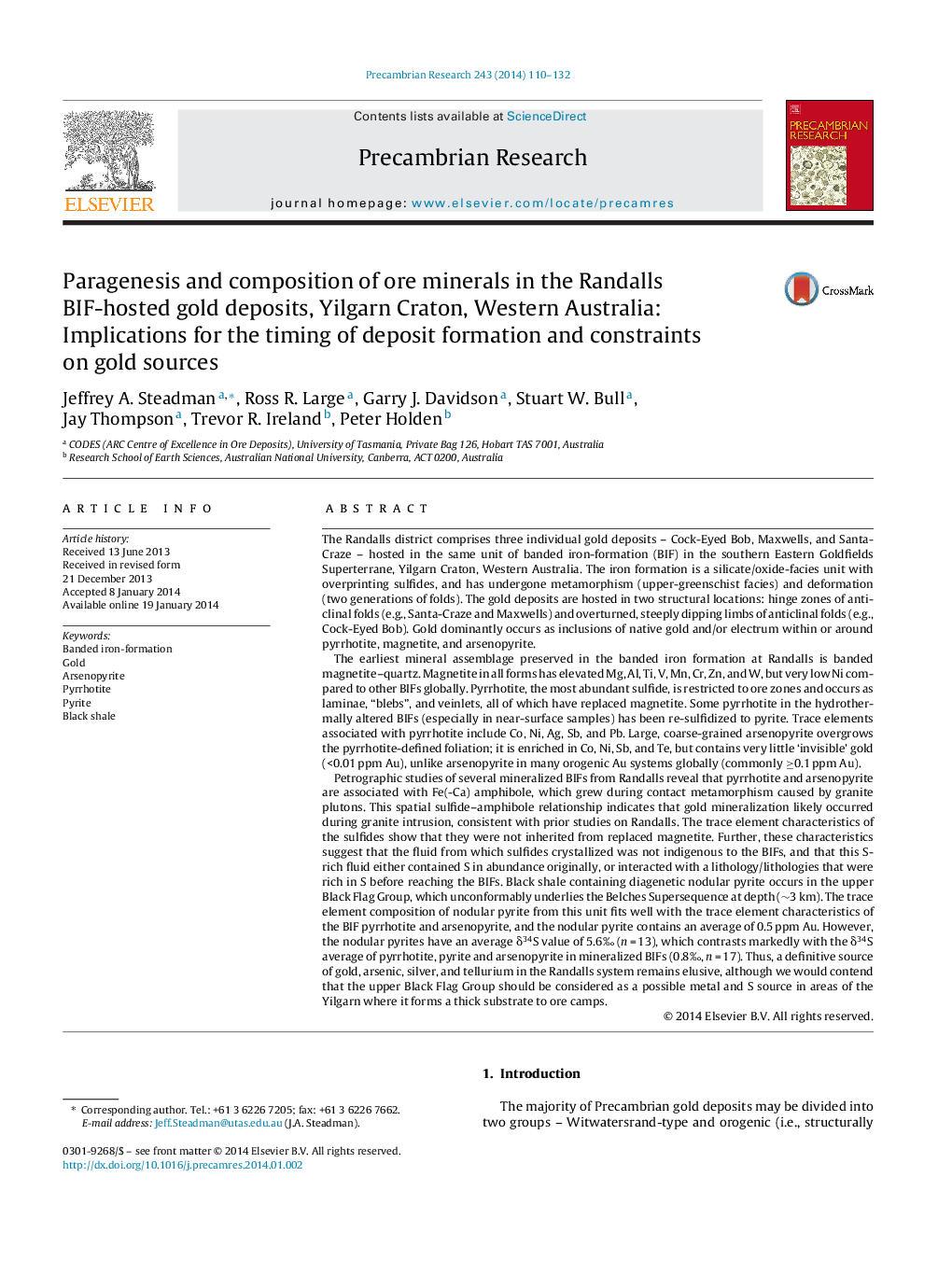| کد مقاله | کد نشریه | سال انتشار | مقاله انگلیسی | نسخه تمام متن |
|---|---|---|---|---|
| 4722982 | 1639631 | 2014 | 23 صفحه PDF | دانلود رایگان |

• One unit of BIF hosts three Au deposits in the Randalls district, Yilgarn Craton.
• Sulfides in the BIF-Au ore contain As and Te; gold is mainly present as electrum.
• The BIF basin is underlain by black shale belonging to the Black Flag Group.
• This black shale contains early pyrite with As, Te, and Au well above background.
• At least some of the gold in the deposits may have come from the black shale pyrite.
The Randalls district comprises three individual gold deposits – Cock-Eyed Bob, Maxwells, and Santa-Craze – hosted in the same unit of banded iron-formation (BIF) in the southern Eastern Goldfields Superterrane, Yilgarn Craton, Western Australia. The iron formation is a silicate/oxide-facies unit with overprinting sulfides, and has undergone metamorphism (upper-greenschist facies) and deformation (two generations of folds). The gold deposits are hosted in two structural locations: hinge zones of anticlinal folds (e.g., Santa-Craze and Maxwells) and overturned, steeply dipping limbs of anticlinal folds (e.g., Cock-Eyed Bob). Gold dominantly occurs as inclusions of native gold and/or electrum within or around pyrrhotite, magnetite, and arsenopyrite.The earliest mineral assemblage preserved in the banded iron formation at Randalls is banded magnetite–quartz. Magnetite in all forms has elevated Mg, Al, Ti, V, Mn, Cr, Zn, and W, but very low Ni compared to other BIFs globally. Pyrrhotite, the most abundant sulfide, is restricted to ore zones and occurs as laminae, “blebs”, and veinlets, all of which have replaced magnetite. Some pyrrhotite in the hydrothermally altered BIFs (especially in near-surface samples) has been re-sulfidized to pyrite. Trace elements associated with pyrrhotite include Co, Ni, Ag, Sb, and Pb. Large, coarse-grained arsenopyrite overgrows the pyrrhotite-defined foliation; it is enriched in Co, Ni, Sb, and Te, but contains very little ‘invisible’ gold (<0.01 ppm Au), unlike arsenopyrite in many orogenic Au systems globally (commonly ≥0.1 ppm Au).Petrographic studies of several mineralized BIFs from Randalls reveal that pyrrhotite and arsenopyrite are associated with Fe(-Ca) amphibole, which grew during contact metamorphism caused by granite plutons. This spatial sulfide–amphibole relationship indicates that gold mineralization likely occurred during granite intrusion, consistent with prior studies on Randalls. The trace element characteristics of the sulfides show that they were not inherited from replaced magnetite. Further, these characteristics suggest that the fluid from which sulfides crystallized was not indigenous to the BIFs, and that this S-rich fluid either contained S in abundance originally, or interacted with a lithology/lithologies that were rich in S before reaching the BIFs. Black shale containing diagenetic nodular pyrite occurs in the upper Black Flag Group, which unconformably underlies the Belches Supersequence at depth (∼3 km). The trace element composition of nodular pyrite from this unit fits well with the trace element characteristics of the BIF pyrrhotite and arsenopyrite, and the nodular pyrite contains an average of 0.5 ppm Au. However, the nodular pyrites have an average δ34S value of 5.6‰ (n = 13), which contrasts markedly with the δ34S average of pyrrhotite, pyrite and arsenopyrite in mineralized BIFs (0.8‰, n = 17). Thus, a definitive source of gold, arsenic, silver, and tellurium in the Randalls system remains elusive, although we would contend that the upper Black Flag Group should be considered as a possible metal and S source in areas of the Yilgarn where it forms a thick substrate to ore camps.
Journal: Precambrian Research - Volume 243, April 2014, Pages 110–132